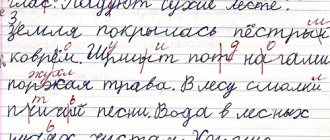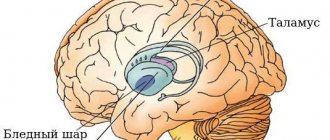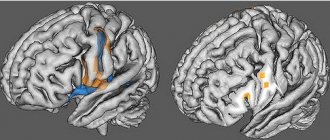Aphasia is a systemic speech disorder that occurs with organic lesions of the brain, covers different levels of speech organization, affects its connections with other mental processes and leads to disintegration of the entire mental sphere of a person.
Aphasia includes four components - a violation of speech itself and verbal communication, a violation of other mental processes associated with speech, a change in personality and personal reaction to the disease.
The causes of aphasia are cerebral circulation disorders (ischemia, hemorrhage), trauma, tumors, and infectious diseases of the brain. Aphasia of vascular origin most often occurs in adults. As a result of rupture of cerebral aneurysms, thromboembolism caused by rheumatic heart disease, and traumatic brain injuries, aphasia is often observed in adolescents and young adults.
The complexity of the speech disorder in aphasia depends on the location of the lesion. A.R. Luria distinguishes six forms of aphasia:
- acoustic-gnostic and acoustic-mnestic aphasia, which occurs when the temporal parts of the cerebral cortex are damaged,
- semantic aphasia and afferent motor aphasia, arising from damage to the lower parietal parts of the cerebral cortex,
- efferent motor aphasia and dynamic aphasia, which occur with damage to the premotor and posterior frontal parts of the cerebral cortex (on the left in right-handed people).
When speech zones are damaged, there is a violation of the so-called primary prerequisite that carries out the specific activity of the corresponding analyzer system. Based on the primary analytical disturbance, a secondary, also specific, collapse of the entire functional system of language and speech occurs, i.e. There is a violation of all types of speech activity: understanding speech, oral and written speech, counting, etc.
ACOUSTIC-GNOSTIC SENSORY APHASIA
This form of aphasia is characterized by impaired understanding of speech when perceiving it by ear. The basis of speech acoustic agnosia is a violation of phonemic hearing. Someone else's speech is perceived as an inarticulate stream of sounds. Inability to understand the speech of others and the absence of obvious motor disorders leads to the fact that patients do not always immediately realize that they have a speech disorder associated with a stroke or injury.
With sensory aphasia, the root lexical-semantic part of a word is difficult to catch by ear, resulting in a loss of its subject relevance. However, the categorical attribution of a word can be “perceived.” For example, hearing the word bell, the patient says: “It’s something small, but I don’t know what.” In patients with acoustic-gnostic sensory aphasia, auditory control of their speech is disrupted. Because of this, many literary and verbal paraphasias arise.
The patient’s early speech may be completely incomprehensible to others; it consists of random sets of sounds, syllables, and phrases, which is called “jargonophasis” or “speech hash.”
Due to a violation of phonemic perception, the repetition of words suffers a second time, and the rhythmic and melodic basis is lost. The period of jargonophasia lasts no more than 1.5 - 2 months, gradually giving way to logorrhea with pronounced agrammatism. In the study of the nominative function in sensory, acoustic-gnostic aphasia, along with correct naming, attempts are observed to explain the meaning of the word or find it through the phraseological context. For example, when naming an apple, it is said: “Well, of course, I know very well that it is a pear, not a pear, a sour apple,” etc.
When reading, many literary paraphasias appear, difficulty arises in finding the place of stress in a word, which makes reading comprehension more difficult. But reading remains the most preserved speech function in sensory aphasia.
Written speech is impaired to a greater extent and is directly dependent on the state of phonemic hearing. Severe counting disorders in sensory acoustic-gnostic aphasia are observed only at a very early stage.
Why does a person lose the ability to speak?
The main reason why already formed speech may disappear is a gross disruption of the functioning of areas of the cerebral cortex. The reasons for such a lesion in acoustic-gnostic aphasia can be any. These are injuries and strokes, neurodegenerative and infectious diseases, tumors. In children, the condition is most often caused by:
- traumatic brain injuries;
- abscesses inside the skull;
- cerebral aneurysms;
- meningitis and encephalitis.
There are other, no less serious reasons for the disappearance of speech skills. Aphasia may be the first symptom of these severe, life-threatening diseases, so if a child experiences a gradual decline in speech development, a visit to a neurologist is required. If speech is suddenly lost, you need to take a closer look at the child and consult with a neurologist as quickly as possible, who can examine the baby in person.
ACOUSTIC-MNESTIC APHASIA
Acoustic-mnestic aphasia occurs when the middle and posterior parts of the temporal region are damaged. It is believed that it is based on a decrease in auditory-verbal memory, which is caused by increased inhibition of auditory traces. Acoustic-mnestic aphasia is characterized by a dissociation between the relatively intact ability to repeat individual words and the impaired ability to repeat three or four unrelated words (for example: hand-house-sky, etc.)
In acoustic-mnestic aphasia, speech memory impairment is the main defect, because phonemic hearing and the articulatory side of speech are preserved. Increased speech activity compensates for communication difficulties. The auditory verbal memory of these patients is characterized by great inertia.
Violation of the volume of retention of speech information, its inhibition leads to difficulties in understanding in this form of aphasia long, polysyllabic statements consisting of five to seven words. Patients find it difficult to navigate a conversation with two or three interlocutors, “switch off” in a difficult speech situation, cannot attend reports, lectures, and get tired when listening to music and radio broadcasts. This fact should be taken into account when prescribing such treatment methods as “art therapy”, etc.
With optical aphasia, the second variant of acoustic-mnestic aphasia, difficulties arise in retaining the semantic aspect of speech by ear; they consist in weakening and impoverishment of visual representations of an object, in the relationship between what is perceived by ear and its visual representation. The visual representation of an object becomes incomplete; those elements of objects that, on the one hand, are specific to them, and on the other hand, are associated with the polysemy of the word (for example, the words spout, comb, pen) are not completed.
Patients understand the meaning of individual words. They do not have articulatory difficulties, they are not only verbose, but also hyperactive. However, with all this, they only partially understand speech due to the narrowing of auditory-verbal memory to 1-2 out of 3 words perceived by ear. Speech is abundant, little informative, replete with verbal paraphasias, but intonation-colored.
In written speech with acoustic-mnestic aphasia, the phenomena of expressive agrammatism appear more prominently, i.e. displacement of prepositions, as well as inflections of verbs, nouns and pronouns, mainly in gender and number. The nominative side of written speech turns out to be more preserved. When recording text from dictation, patients experience significant difficulties in retaining even a phrase in their auditory-verbal memory. Consisting of three words, they are asked to repeat each fragment of the phrase.
With acoustic-mnestic aphasia, it is difficult to perceive printed text when reading. This is due to impaired preservation of auditory-verbal memory.
Manifestations of the disorder
In a patient with any type of aphasia, speech in general is impaired. A person, when speaking, swaps syllables and individual sounds; literal paraphasias, perseverations, and also contaminations are characteristic. A person begins to make abnormally long pauses between words and phrases. There is hypophonia, that is, a voice similar in volume to a whisper. The rhythm and melody of speech are also impaired in aphasia. If a person develops an efferent motor type of disorder, he pronounces certain sounds normally.
Since reading and writing are impaired in the disorder in question, phenomena such as dysgraphia (the extreme form of which is agraphia) and dyslexia (the extreme form is alexia) are observed. With dysgraphia, a person does not write in capital letters; everything is written urgently. The handwriting of such a person is difficult to understand. He makes many mistakes when writing. Children with this disorder have an extremely difficult time with dictations.
With agraphia, the patient's intellect is preserved, but he cannot write. The cause should be differentiated from hand coordination disorders. With agraphia, a person misses words, cannot combine letters and syllables with each other, and grossly distorts words when writing. Dyslexia to the inability of a person to read, while the patient’s other cognitive abilities are normal.
With afferent motor aphasia, there can be 2 development options. First: there is a speech embolus, there is no spontaneous speech, or articulatory apraxia is recorded. Second: situational speech is normal, but voluntary speech is difficult or completely absent. Secondary processes of hearing impairment are typical for the afferent subtype of motor aphasia. Writing also suffers.
Acoustic-gnostic or sensory aphasia is characterized by the following manifestations:
- normal physical hearing
- impairment of auditory perception of phrases and sentences
Symptoms of Wernicke's aphasia:
- lack of control over one's speech
- not understanding what others say
- compensatory processes in the form of verbosity
- at the beginning of the development of the disease, for one and a half or two months, a person utters spontaneous sets of sounds and words, which is called jargonphasia in the medical literature
- at the beginning of the disease, speech does not make sense to others
- after the stage described above, logorrhea occurs, the person uses verbal and literal paraphasias
- the person may have difficulty writing or may not be able to write at all
- reading skills maintained
Symptoms of acoustic-mnestic aphasia:
- the information heard “does not stay in the brain”
- misunderstanding long phrases
- inability to repeat 3-4 words heard in a row
- a person is unable to speak with two/three or more people at once
- increased speech activity
Amnestic-semantic aphasia has the following symptoms:
- anomia (the patient does not remember the name of this or that object)
- The patient does not understand complex speech patterns or understands them with difficulty
- understanding of cause-and-effect, spatial and temporal verbiage is lost
- a person does not understand words used figuratively, metaphors, etc.
- violation of counting operations
- reading comprehension
Manifestations of dynamic aphasia:
- individual words and phrases are pronounced normally
- repetition is normal
- impossibility of spontaneous narrative speech
- the person doesn't talk much
- perseveration in speech
- echolalia (repetition of phrases spoken by the interlocutor)
- preservation of arithmetic operations, writing and text reading skills
SEMANTIC APHASIA
Semantic aphasia occurs when there is damage to the overlap area of the three lobes of the cerebral cortex - parietal, occipital and temporal. Speech disorders of the amnestic aphasia type are based on the collapse of the semantic structure of the word, the impoverishment of the near and far connections of the word.
Semantic aphasia is combined with pronounced spatial-constructive apraxia and apraxia of finger posture. Patients with semantic aphasia retain their understanding of elementary phrases that convey “communication of events,” for example: “The children are going into the forest. They will collect mushrooms. They should return home by evening." Such phrases can consist of 7-11 elements and can be easily understood by patients with this form of aphasia.
Patients understand well the meaning of individual prepositions, freely place a pencil under a spoon or a spoon to the right of a fork, but cannot place three objects. Patients cannot navigate comparative phrases like “Kolya is taller than Misha and shorter than Vasya.”
Difficulties arise with semantic aphasia in solving logical-grammatical phrases that convey communication of relationships such as “father’s brother” - “brother’s father,” etc.
Patients also find it difficult to understand complex syntactic structures expressing cause-and-effect, temporal and spatial relationships, adverbial and participial phrases. They do not understand metaphors, proverbs, sayings, popular words, and the figurative meaning is not found in them.
Expressive speech is articulatory preserved, there are no literary paraphasias, there is no pronounced agrammatism, but in written and oral speech patients do not use complex lexical complexes, which is why the vocabulary becomes semantically poor. Poverty of vocabulary is expressed in the rare use of adjectives, adverbs, descriptive phrases, participial and participial phrases, proverbs, sayings. There is no semantic intonation in speech.
Written speech is distinguished by its poverty, stereotypical syntactic forms, and there are few complex, complex sentences in it. The use of adjectives is reduced. Gross violations of counting operations are often observed. Patients confuse the direction of action when solving multi-digit arithmetic examples, they experience certain arithmetic difficulties when working with the transition through ten, and have difficulty writing multi-digit numbers by ear.
AFFERENT MOTOR APHASIA
Afferent motor aphasia occurs with damage to the secondary zones of the postcentral and inferior parietal parts of the cerebral cortex, located posterior to the central or Rolandic sulcus.
There are two types of this aphasia. The first type of aphasia is observed with damage to the postcentral parts of the left hemisphere in both right-handers and left-handers, and is characterized by a complete loss of expressive speech. The second type of aphasia is observed in persons who were retrained in preschool and primary school age from the left hand to the right.
In the first variant of afferent kinesthetic motor aphasia, severe apraxia of the articulatory apparatus can lead to a complete absence of spontaneous speech. Attempts to arbitrarily repeat sounds lead to chaotic movements of the lips and tongue and literary substitutions. Patients split a closed syllable into two open ones, split up consonant clusters in a syllable, and omit consonant sounds. And at the same time the words here, there, here, etc. sound like tu-t, ta-t, vo-t, etc.
In the process of complex treatment of patients after a stroke at the Vremena Goda clinic, there is a rapid restoration of understanding of situational conversational speech, understanding of the meanings of individual words, and the ability to follow simple instructions. Patients have been experiencing specific features of impaired understanding for a long time. This is due to secondary phonemic hearing impairment. With this form of aphasia, difficulties arise in recognizing by ear words with sounds that have common features in the place of words with sounds that have common features in the place and method of articulation (rough - front-lingual, sonorant - vowels, etc. There are difficulties in understanding lexical means languages that convey various complex spatial relationships.
Difficulties in understanding are caused by verbs with prefixes (wrap, return, etc.), in understanding the meanings of personal pronouns used in indirect cases, which is explained by the lack of subject orientation in them, the abundance of phonemic changes (for example, me-me-me).
Reading and writing disorders depend on the severity of apraxia of the articulatory apparatus. In the process of neurorehabilitation in our clinic, the restoration of internal reading often precedes the restoration of written speech. When writing words under dictation, when naming objects in writing, when trying to communicate in writing with others, all articulatory difficulties affect themselves, i.e. There are numerous literary paragraphs reflecting a mixture of vowel and consonant phonemes that are close in place and method of articulation; consonants (sonorant) are omitted.
In the second variant of afferent motor aphasia, patients have difficulty maintaining the order of letters in a word, imagining their mirroring, skipping vowels, or writing all the consonants first, and then the vowels, and they retain the idea of the presence of a sound in a word, for example, skipping the letter “е” ", in the word "leads", the patient puts two dots over the "d".
Types of aphasia, their symptoms and features
Today, there are several types of classification of aphasia. Based on anatomical, psychological and linguistic criteria, there are classical divisions of forms of the disease, neurological, linguistic, etc.
A. R. Luria most fully revealed the issue of dividing aphasia by type, ultimately identifying six varieties of this disease. Its classification is still considered the most comprehensive and generally accepted in world practice. According to this neuropsychological division, the following forms of aphasia are distinguished:
- afferent motor;
- efferent motor;
- acoustic-gnostic (sensory);
- acoustic-mnestic;
- semantic aphasia;
- dynamic.
These forms are generally classified into three large groups. Thus, afferent, efferent and dynamic forms of aphasia are classified as a group of motor disorders. A distinctive feature of this type of disease is the absence of expressive speech, that is, active oral utterance.
Acoustic-gnostic and semantic aphasia belong to the group of impressive disorders, where a person is unable to understand spoken language. If the patient is unable to name individual objects, acoustic-mnestic aphasia or an amnestic form of the disease occurs.
Different parts of the brain are responsible for one or another element of the structure of our speech. The form of the disease will depend on where the lesion is located. The division of aphasia into types is explained by the different ways and degrees of its manifestation. With the total form of the disease, complete recovery of the patient is almost impossible.
Afferent aphasia
With this form of the disease, a person cannot utter almost a single word. In severe or total form of manifestation, the patient is not able to utter even a sound. However, a person can involuntarily pronounce words and sounds. But he will not be able to do this when asked to repeat this or that sound or word. The patient cannot imagine how to close or open his mouth, where to place his tongue, etc. That is, the person cannot understand what exactly needs to be done to make any sound.
Afferent motor aphasia provokes a breakdown of connections between the human articulatory apparatus and sound expressions. If it is possible to pronounce any sounds, an adult or a child may confuse those that are similar in pronunciation, for example, “b” and “p” or “k” and “x,” etc. It also manifests itself in the difficulty of writing letters in the correct order. This phenomenon is especially often observed in retrained left-handers. They can skip only vowels or only consonants in words.
The disease leads to the patient's inability to express his articulatory abilities. Such people, as a rule, cannot fold their tongue into a tube, click their tongue, or make other linguistic gestures.
Efferent
Efferent motor aphasia is caused by a disorder in the part of the cerebral cortex that is responsible for programming speech, when one sound or syllable flows into another, resulting in the formation of words. This part of the brain is called Broca's area. Therefore, this form of aphasia is often called Broca's aphasia.
In this case, a person, at the request or of his own free will, can pronounce individual sounds. However, such patients cannot combine sounds into words, switch from one syllable to another to form a whole word, or such speech actions are given to them with great difficulty. In severe forms of the disease, a person begins to communicate using gestures and facial expressions or using the so-called word embolus. That is, the patient can utter one word, which he uses for all questions, requests or appeals to him.
With a less pronounced form of efferent aphasia, the patient’s speech becomes scanty and simple. Such a person does not use prepositions and cannot change words according to cases. Often this type of aphasia is characterized by a mixture of syllables and letters in the patient’s phrases. Efferent motor aphasia may result in a person's inability to read aloud.
Acoustic-gnostic (sensory)
Acoustic-gnostic, or sensory, aphasia occurs as a result of damage to the upper part of the temporal cortex of the brain. It is this area, which is called Wernicke’s area, that is responsible for a person’s perception and understanding of the auditory part of speech. In a person with this form of the disease, the phonemic analysis of spoken words is impaired. That is, the patient only partially or completely does not understand the speech addressed to him.
At the same time, physical hearing in such people is not impaired. They can put syllables into words and speak. They easily pronounce simple and familiar words, but are unable to verbally reproduce complex and unfamiliar ones. With this type of aphasia, a person's speech is simple but confused. It is very difficult to understand the meaning of what was said due to a violation of the structure of the composed sentence.
Often these patients speak very quickly, emotionally, but incoherently. You might think that a person speaks some kind of “his own” language. People with this form of the disease lose the ability to write words and sentences or read aloud. With such aphasia, the patient himself may not be aware of the speech impairment. He does not understand that he is making mistakes in the pronunciation of words, syllables or letters.
Acoustic-mnestic
Amnestic aphasia is manifested by a violation of auditory-verbal memory. The patient exhibits forgetfulness. A person knows exactly the purpose of an object, but does not remember what it is called and cannot name it. “Well, this one, call, hello, I have one like this at home, how did I forget?” (Phone) “I like it so yellow, juicy, with segments, they also peel it, and it smells delicious” (Orange). Patients do not understand the meaning of synonyms, antonyms, and cannot find a generalizing word for a group of concepts (furniture, shoes, toys).
The figurative meaning of words is also incomprehensible to a patient with this form of aphasia. Thus, he perceives the phrase “golden hands” as “hands made of gold.” This type of disorder occurs against the background of pathology of the inferior temporal region of the hemisphere.
The main characteristic of this form of aphasia is expressed in vocabulary deficit. The speech of such people is spontaneous and emotional and mainly contains verbs. Acoustic-mnestic aphasia is often accompanied by defects in counting and other arithmetic operations. Moreover, such patients read well. In contrast to the sensory form of the disease, acoustic-mnestic aphasia is characterized by preservation of phonemic hearing.
Semantic
This form of the disease occurs when the inferior parietal lobe of the hemisphere is affected. Semantic aphasia is manifested by the patient's inability to compare time and space. Such people understand speech perfectly, speak well and correctly, and fulfill simple requests. Semantic aphasia provokes a violation in the understanding of logical connections in speech structures. Patients do not understand the meaning of prepositions that determine location. The words “run”, “run”, “run away”, “run” are equivalent for them.
In addition, it is difficult for them to grasp the concepts of belonging, for example, “daddy’s daughter” and “daughter’s daddy,” etc. Patients with semantic aphasia do not understand the figurative meaning of words, sayings, and proverbs. With this type of aphasia, patients are able to read, but cannot retell what they read in their own words.
Dynamic
Dynamic aphasia is another type of motor aphasia, when the area of the brain located next to Broca's area is affected. These are the anterior and middle sections of the inferior frontal gyrus. The speech activity of the patient with this type of aphasia is reduced. It seems that the speaker does not want to engage in dialogue.
The patient's speech is scanty, spontaneous and slow, there is no dynamics or expressiveness in it. There is an absence of verbs, prepositions, complex adjectives and interjections in the phrases. The words are not consistent with each other, the grammatical forms of the words are not consistent “Grandma...read...book.” “The dog...sit..barked...now.”
Very often, a patient experiences several forms of aphasia at once. The mixed form is formed due to the anatomical proximity of those areas of the brain that are responsible for the perception and reproduction of speech. Thus, with extensive damage to the blood vessels of the brain, a mixed type of disease occurs - sensory-motor aphasia. The patient has no phonemic hearing and articulation is impaired. Understanding of oral and written speech is completely impaired.
Sensorimotor aphasia refers to the total form of the disease. Each type of aphasia is characterized by certain symptoms. But with any form of the disease, speech impairment is necessarily observed.
EFFERENT MOTOR APHASAIA
When the premotor zone is damaged, efferent motor aphasia occurs. The linear, temporary organization of movement is carried out by the premotor areas of the cerebral cortex. In case of damage to the secondary fields of the nuclear zone, motor skills are disrupted; while individual movements are preserved, motor persistence occurs. When different parts of the frontal lobes are disturbed, inactivity, persistence, duration of pause in activity occur, mental and motor processes lose their smoothness, “dynamic” or “kinestatic” replacement of one movement or action by another. The smoothness and melody of not only movements, but also speech disappears.
Several patients undergoing neurorehabilitation after a stroke at the Vremena Goda clinic, among other disorders, had motor aphasia with pathological inertia of speech stereotypes, leading to sound, syllable, lexical rearrangements and repetitions. This was explained by the impossibility of timely switching from one articulatory act to another; such violations make it difficult, and sometimes completely impossible, to speak, write, and read.
The sound structure of syllables in efferent motor aphasia is not simplified or destroyed, but loses its intonation coloring and becomes stringy and monotonous. Literal paraphasias are not typical for the oral speech of patients with efferent motor aphasia, but there are many of them in written speech.
Impaired reading and writing are characteristic of efferent motor aphasia. Recording a word or phrase is possible only when pronouncing the words syllable by syllable. Perseverations of letters from previous words and perseverations of the same syllable are frequent. At the later stages of recovery, when independently compiling a text based on a series of paintings, agrammatism is revealed, and inflections, both case and indicating gender, are mixed. In severe cases, reading is guessing in nature.
Diagnostics
Diagnosis of aphasia requires the following measures:
- Examination by a neurologist. The examination reveals visual impairment, unilateral weakening of muscle strength and impaired activity of the extraocular muscles.
- Magnetic resonance and computed tomography, general and biochemical blood tests, study of the blood circulation of the temporal cortex, spinal puncture to analyze cerebrospinal fluid.
- Consultation with a psychiatrist. This is required by differential diagnosis. After a traumatic event, the patient's pathological condition resembles psychosis or bipolar affective disorder.
DYNAMIC APHASAIA
This aphasia occurs when there is damage to the posterior frontal parts of the left, speech-dominant hemisphere, the block of activation, regulation and planning of speech activity. And dynamic aphasia is characterized by the main speech defect - this is the difficulty, and sometimes the complete impossibility, of actively developing a statement. We can say that the basis of dynamic aphasia is a violation of the internal programming of the utterance, manifested in the difficulties of its planning when composing individual phrases.
Dynamic aphasia is based on a violation of spontaneous, detailed utterance. When retelling a plot picture, separate, unrelated fragments are pronounced, and the main semantic links are not highlighted.
Pseudo-amnestic difficulties may be observed when naming objects, especially when remembering the names of familiar people, names of cities, etc. The hint of the first syllable of a word can be a trigger that releases the inertia of the speech search for words. Significant difficulties are experienced when asked to perform a reverse ordinal count. For example, from ten to one.
Dynamic aphasia is characterized by intact reading and writing. Elementary counting in dynamic aphasia remains intact, but with this aphasia the solution of arithmetic problems that require the construction of an action plan is sharply impaired.
Organic lesions of the motor parts of the central nervous system caused by stroke (ischemic stroke, hemorrhage) contribute not only to speech impairment in the form of aphasia, but also to such speech disorders as dysarthria.
DYSARTHRIA
Dysarthria is a violation of the pronunciation side of speech, caused by a violation, insufficiency, of the innervation of the speech apparatus.
Clinical forms of dysarthria are determined depending on which part of the motor system is affected. In all forms of dysarthria, sound pronunciation is impaired due to inaccurate motor installation for reproducing phonemic features. The intelligibility of pronunciation decreases due to increased salivation and the appearance of characteristic squelching sounds. The prosodic characteristics of speech are also impaired.
Depending on the location of the lesion, bulbar, pseudobulbar, extrapyramidal, cerebellar and cortical forms are distinguished. Topical classification of dysarthria according to E.N. Vinarskaya.
Bulbar form of dysarthria
Caused by damage to the nuclei, roots or peripheral trunks of the cranial nerves located in the medulla oblongata. With such lesions, flaccid paralysis develops in the muscles of the speech organs, leading to the loss of any movements - voluntary and involuntary. Due to the fact that the lesion may be focal in nature, the actions of certain muscles are therefore excluded from the act of pronunciation. Restricted muscle movement leads to persistent pronunciation problems. With the most severe disorders, the range of pronounced sounds can be narrowed to 2-3. Additional overtones appear in the speech of patients, caused by the disorder due to additional muscle tension. Speech intelligibility suffers in proportion to the severity and prevalence of paralysis and paresis in the oral region. Both voluntary and involuntary movements are impaired. There is vagueness, muffled sound pronunciation, and nasalization of sounds.
Pseudobulbar form of dysarthria
Occurs when the pyramidal tracts are damaged in the area from the cortex to the medulla oblongata. With this localization of the lesion, spastic paralysis with impaired control of voluntary movements is characteristic. Highly automated movements, regulated at the subcortical level, are preserved. In speech, sounds that are complex in articulation and require more precise muscle movements are selectively affected. Increased tone of the muscles of the tongue and pharynx, limited movement of the lips and tongue, drooling, and oral synkinesis are detected. Speech is monotonous, blurred, voice is unmodulated.
Extrapyramidal dysarthria
It is a consequence of damage to the extrapyramidal system. Control of muscle tone is impaired. Dystonia occurs and the most characteristic symptoms are hyperkinesis. Hyperkinesis manifests itself in the form of rhythmic muscle contractions (choreic hyperkinesis) and wave-like movements (athetoid hyperkinesis). Hyperkinesis intensifies as the movement becomes more complex and the level of its arbitrariness increases. Therefore, with extrapyramidal dysarthria, disorders in the pronunciation of articulatory complex sounds and pronounced disturbances in the prosodic components of speech are observed.
Cortical dysarthria
Consequence of focal lesions of the motor areas of the cerebral cortex. Characteristic disorders include disorganization of complex motor skills. The hierarchical structure of movements disintegrates, and all its elements are essentially equalized. There is no fluency of speech, there may be salivation.
Cerebellar dysarthria
Occurs when the cerebellum or its pathways are damaged, speech is slow, jerky, and scanned. Reduced tone and mobility of the tongue muscles. Severe disturbances in the tempo and fluency of speech.










